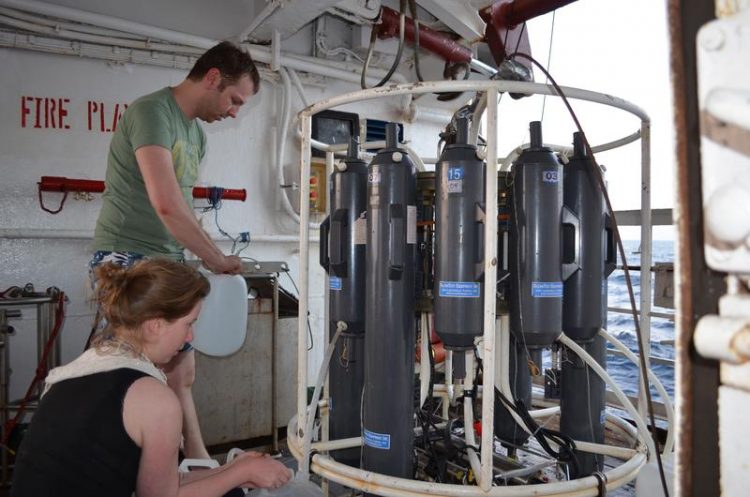A new dead zone in the Indian Ocean could impact future marine nutrient balance

1) Onboard of the research vessel ORV Sagar Kanya in the Bay of Bengal: In February 2014 scientists collected seawater samples from different water depths at seven stations. Cameron Callbeck (MPI) and Morten Larsen (SDU)
New research published in the journal Nature Geosciences shows that the Bay of Bengal, located in the northeastern Indian Ocean, also hosts a “dead zone” of an estimated 60,000 km2 and occupying water depths of between 100 and 400 meters.
This research was conducted as cooperation between the University of Southern Denmark (SDU), the Max Planck Institute (MPIMM) for Marine Microbiology in Bremen and the National Institute of Oceanography (NIO) of India. Lead author of the study Laura Bristow, a former postdoc at SDU and now a scientist at the MPI explains:
“The Bay of Bengal has long stood as an enigma because standard techniques suggest no oxygen in the waters, but, despite this, there has been no indication of nitrogen loss as in other ‘dead zones’ of the global ocean”.
Using newly developed oxygen-sensing technology, the researchers demonstrated that some oxygen does exist in the Bay of Bengal waters, but at concentrations much less than standard techniques could detect, and some 10,000 times less than that found in the air-saturated surface waters.
The researchers also discovered that the Bay of Bengal hosts microbial communities that can remove nitrogen, as in other well-known “dead zones” and even some evidence that they do remove nitrogen, but at really slow rates.
Bristow continues: “We have this crazy situation in the Bay of Bengal where the microbes are poised and ready to remove lots more nitrogen than they do, but the trace amounts of oxygen keep them from doing so”. Wajih Naqvi, former director of NIO, and a co-author of the study, adds:
“Remove the last amounts of oxygen, and the Bay of Bengal could become a major global player in nitrogen removal from the oceans”. Removing more nitrogen from the oceans could affect the marine nitrogen balance and rates of marine productivity.
Globally, warming of the atmosphere through climate change is predicted to lead to an expansion of “dead zones” in the ocean. It is currently unclear whether climate change would lead to the removal of these last traces of oxygen from the Bay of Bengal waters.
However, the Bay of Bengal is also surrounded by a heavy population density, and expected increases in fertilizer input to the Bay may increase its productivity, contributing to oxygen depletion at depth. Bristow warns: “Time will tell, but the Bay of Bengal is at a “tipping point”, and we currently need models to illuminate how human activities will impact the nitrogen cycle in the Bay of Bengal, and also globally”.
For more information please contact
Dr. Laura Bristow +49 421 2028 634, lbristow@mpi-bremen.de
Max Planck Institute for Marine Microbiology, Celsiusstr. 1, D-28359 Bremen
or contact the press team
Dr. Manfred Schloesser, +49 421 2028704, mschloes@mpi-bremen.de
Dr. Fanni Aspetsberger, +49 421 2028947, faspetsb@mpi-bremen.de
Institutions
Department of Biology and Nordic Center for Earth Evolution (NordCEE), University of
Southern Denmark, Campusvej 55, 5230 Odense M, Denmark.
Max Planck Institute for Marine Microbiology, Celsiusstrasse 1, 28359 Bremen, Germany.
School for Marine Science and Technology, University of Massachusetts Dartmouth, 706 South
Rodney French Blvd, New Bedford, MA 02744-1221, USA.
CSIR-National Institute of Oceanography, Dona Paula, 403 004, Goa, India,
Department of Biological Sciences, Aarhus University, Building 1540, DK-8000 Aarhus C, Denmark.
Original article
N2 production rates limited by nitrite availability in the Bay of Bengal oxygen
minimum zone
L.A. Bristow, C.M. Callbeck, M. Larsen, M.A. Altabet, J. Dekaezemacker, M. Forth, M. Gauns, R.N. Glud, M.M.M. Kuypers, G. Lavik, J. Milucka, S.W.A. Naqvi, A. , Pratihary, N.P. Revsbech, B. Thamdrup, A.H. Treusch, D.E. Canfield. Nature Geoscience 2016, DOI 10.1038/ngeo2847
Media Contact
More Information:
http://www.mpi-bremen.deAll latest news from the category: Earth Sciences
Earth Sciences (also referred to as Geosciences), which deals with basic issues surrounding our planet, plays a vital role in the area of energy and raw materials supply.
Earth Sciences comprises subjects such as geology, geography, geological informatics, paleontology, mineralogy, petrography, crystallography, geophysics, geodesy, glaciology, cartography, photogrammetry, meteorology and seismology, early-warning systems, earthquake research and polar research.
Newest articles

First-of-its-kind study uses remote sensing to monitor plastic debris in rivers and lakes
Remote sensing creates a cost-effective solution to monitoring plastic pollution. A first-of-its-kind study from researchers at the University of Minnesota Twin Cities shows how remote sensing can help monitor and…

Laser-based artificial neuron mimics nerve cell functions at lightning speed
With a processing speed a billion times faster than nature, chip-based laser neuron could help advance AI tasks such as pattern recognition and sequence prediction. Researchers have developed a laser-based…

Optimising the processing of plastic waste
Just one look in the yellow bin reveals a colourful jumble of different types of plastic. However, the purer and more uniform plastic waste is, the easier it is to…



